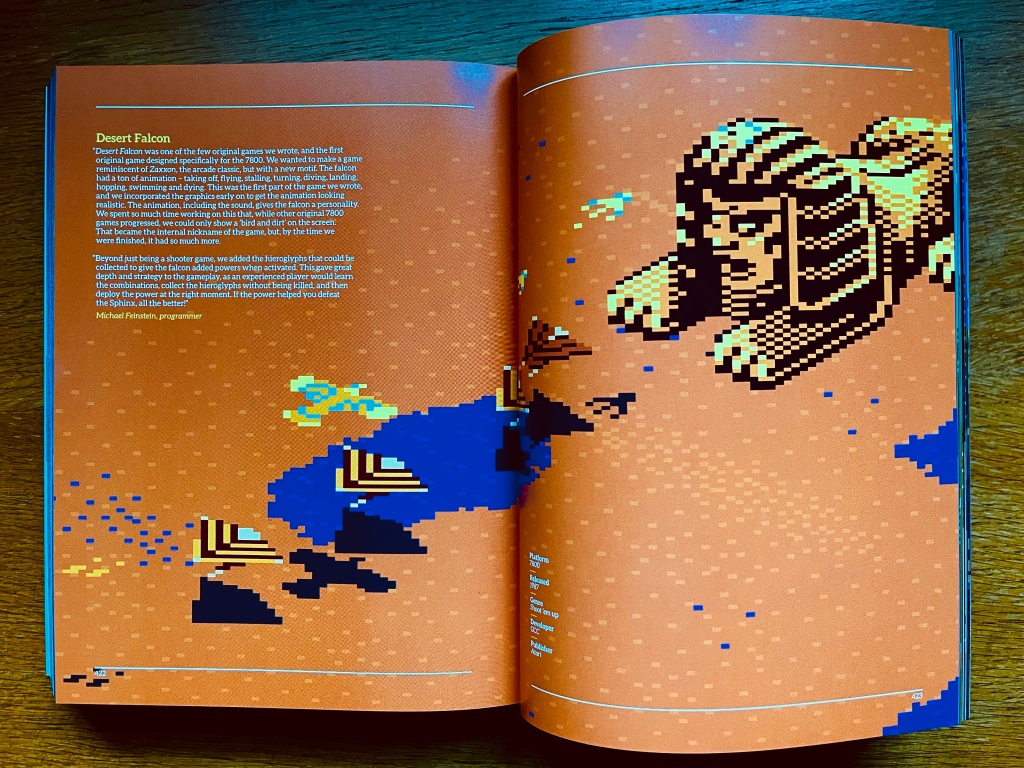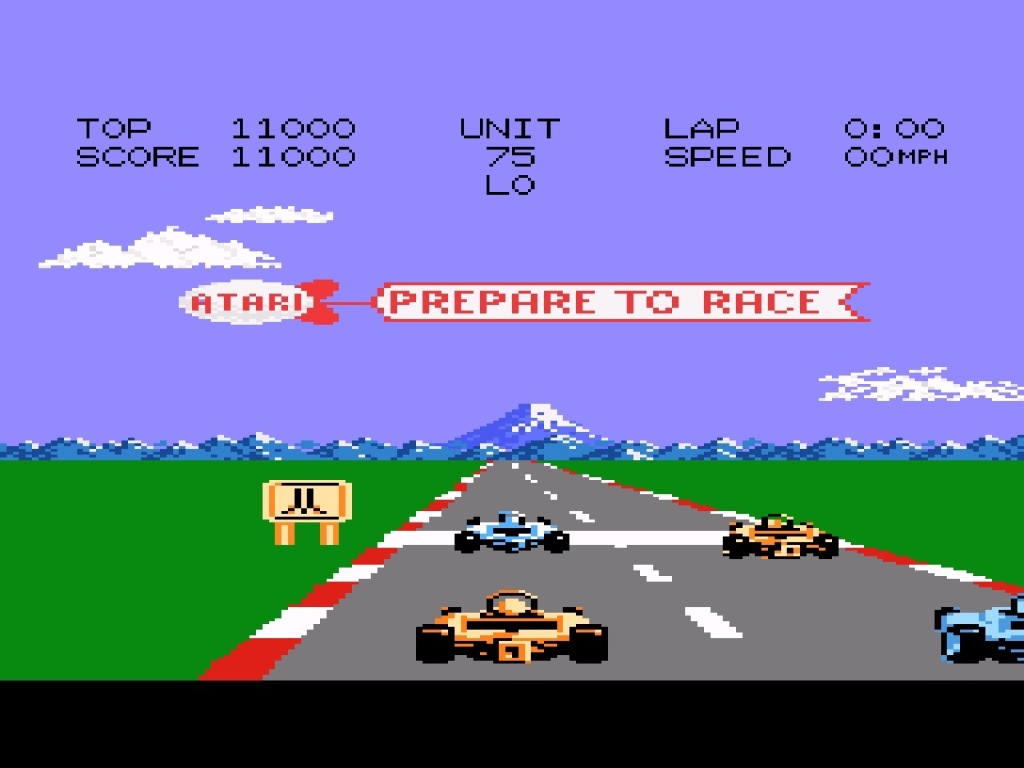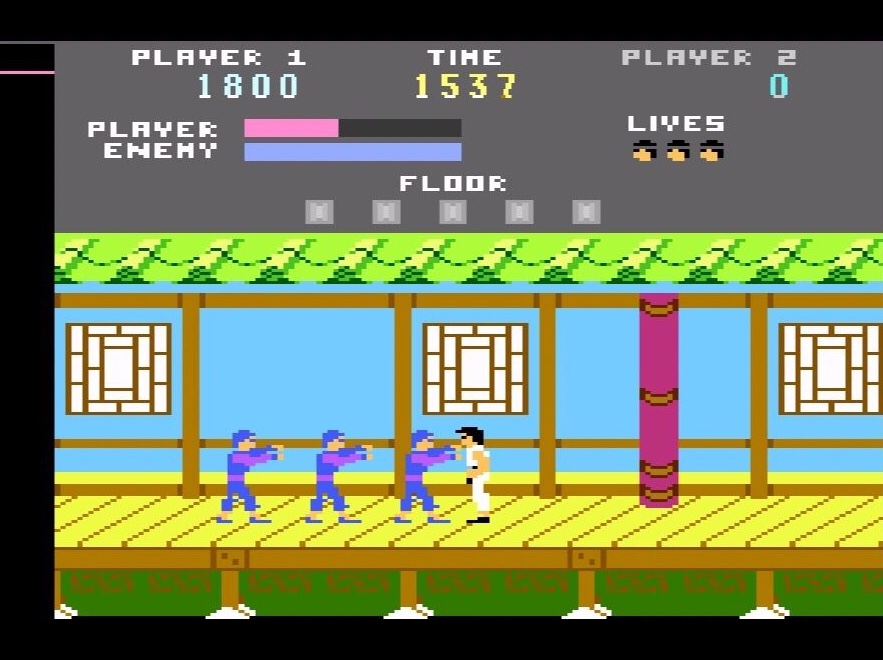By the time you read this it’s going to be at least just about a year since I reviewed Bitmap Books’ wonderful Atari 2600/7800: a visual compendium. As you’d expect from them, it’s a high-quality 528 pages full of histories and interviews, developer profiles and cover art, but mostly there’s features on hundreds and hundreds of Atari 2600 and Atari 7800 games, although predominantly the former as the latter only ever got 59 games officially released. Without repeating history, I’ve got history with the 2600 since the early eighties but up to that review I think I’d played a couple of games on the 7800 at most – my old vertical run and gun favourite Commando and no-holds barred prison-yard basketballer Basketbrawl, which I’d actually only just encountered for the first time at the time when we looked at the Lynx version here.

And with all of that established, I vowed to begin a journey of discovery – my favourite aspect of this retro-gaming lark – to learn more about this mysterious system that was first shelved in 1984 then finally released to fail a couple of years later, along with some of those 59 games. I decided at the time that this journey would begin with Ancient Egyptian Zaxxon-alike Desert Falcon, which it did, and from there I’d picked out “endurance racer” MotorPsycho as the next one to go to town on, solely on the basis of its entry in that book, although there were a few tantalising arcade ports in there too like Pole Position II, Kung-Fu Master and Xevious that I was also keen to try, as well as versions of old favourites Donkey Kong and Winter Games. And I thought that as there’s probably not really a huge amount to MotorPsycho, we could have a really quick look at those now!

I didn’t get to play arcade games a great deal as a kid, but when the local funfair came to town it was all about early 3D racer Pole Position, at least until sit-down Star Wars came along. I’m not sure I’ve ever played any version of the 1983 sequel though, so trying this one’s a real treat for me. And what a treat it is! Really fantastic! Everything seems to be present and correct, and it all moves smoothly and at pace. The car is really responsive too, giving you every chance of not exploding at the slightest touch with another car! What a great conversion to begin with!

One game I did play a lot of was Kung-Fu Master, ironically in the café of the same leisure centre I was learning kung-fu in at the time of its 1984 release! First scrolling beat ‘em up? Arguably yes, but regardless you’re punching and kicking your way through an army of thugs, midgets and dragons in flowerpots to save your girlfriend at the top of the Game of Death-style building she’s being held in in. And what a great-looking building! Loads of detail in the backgrounds as well as the sprites, and some nice music too. Just plays a bit fast and floaty compared to the original, but as ports go (keeping in mind one of the worst ever on the ZX Spectrum for this) it’s not bad at all.

We reviewed the rather marvellous Re-Xevious reimagining of Xevious when it arrived early in 2022, though my history with the original 1983 vertically-scrolling shoot ‘em up was merely an exotic screenshot from the arcade game in Computer & Video Games magazine, at least until the Spectrum version came along about five years later! I’ve played a bit since then though, as well as a dozen other ports and versions, so I think I can do this version some justice. Just like it does the original some justice! It’s accurate, it’s pacey, it’s smooth and it’s authentic, but that music… It’s dreadfully grating and truly awful! Anyway, turn down the volume and you’ve got another superb arcade conversion on the Atari 7800! By the way, I am still planning to have a look at the unreleased but apparently available Atari 2600 and Atari 5200 ports of Xevious sometime too!

I’ve always enjoyed seeking out both official and unofficial versions of Donkey Kong, one of which was possibly the second game I ever bought, Crazy Kong on VIC-20. This official port (albeit thanks to a legal loophole) appeared some time after the majority though, in 1988, a couple of years after the not-dissimilar NES port. It gets a bit of a bum-rap for the music though, which I think is a little unfair – they’ve clearly never played a VIC-20 clone! Anyway, it more or less sounds like the original, and apart from missing the pie factory level (same as NES), this is a fantastic conversion – looks and feels just like Donkey Kong!

Last up in our little 7800 tour is Winter Games from 1987, which sits inside my top twenty games of all-time over on the Commodore 64 so I’m possibly going to be the hardest to please with this one! Actually, what’s there is pretty much perfect, but the problem is it’s not even close to being all there! Okay, maybe missing the two skating events isn’t such a bad thing, but we’ve lost the hotdog too, so that’s the best part of half of the events gone in total, and we’re just left with biathlon, ski jump, bobsled and speed skating, and it’s all over within five minutes. Not quite as atmospheric as the C64 version either but it’s good while it lasts.

Time we jumped to MotorPsycho, developed by BlueSky Software (who I think also did the aforementioned BasketBrawl) and published by Atari in 1990. It’s a bike racer, on the surface akin to something like Enduro Racer, which it’s strange to say preceded this by four years because without any context you’d be forgiven for thinking it might have come from four years before it! That’s the nature of the Atari 7800 and its weird history I guess. We’ll come back to the set-up in a second, but first you can always rely on an old Atari instruction manual to throw up something a bit bonkers, and MotorPsycho’s doesn’t disappoint! “To save wear and tear on your thumb, strap a rubber band around the joystick button that controls acceleration for long play sessions.” I was thinking about that, and I’m fairly sure the only time I ever pulled a stunt like that was with the vector-graphics helicopter simulator Tomahawk on the Spectrum to see how high it would go! I get it though – those old Atari joysticks were killers!

Before we start forcing down fire buttons though, we should go back to the beginning… “You finished it at last! And now you are going crazy waiting to test your sleek, hot, fast customized bike. It absorbs your every waking moment, you dream about it every night. It has become an obsession. And you know just the place to try it out. The annual MotorPsycho Competition (for deranged, psychopathic, and other unusual bike types) is this weekend! Its obstacle-laden course is legendary among motorcycle maniacs. Of course, nobody in their right mind would attempt this course. The die-hard spectators remind you that fan is short for fanatic. They’ve staked out their favourite spots to view the races, and they are waiting for the roar of revving engines, the squeal of tires, the crunch of metal…”

Despite your fellow competitors on the race track, it’s you against the clock across four increasingly challenging tracks, and the faster you go the more points you get. In fact, I think as long as you keep getting faster times, you’ll keep going forever and racking up mega-scores. You get one point for each section of the track completed (helpfully described as “about two inches long on the screen”) but two points if you do it (or possibly some of it) airborne – it’s never very well explained, and one or two points is hard to keep track of when you’re getting a thousand for a high-speed jump, three thousand for jumping over an enemy bike and similar big numbers for cones, signs and ramps! When the game ends, you’ll also be awarded a thousand points for each enemy passed and five thousand for every second on unused play time. It’s all pretty cool actually, allowing for plenty of scope for improvement as you get more skilled, and plenty of risk-reward strategy once you are.

Aside from that accelerator button, you’ve got another button for jump but it seems like when you were busy customising that bike you completely forgot about brakes, so there are none. Instead, you push forward on the stick to shift to high gear and pull back to switch to low gear, which is your best bet for slowing down on sharp turns although it’s hit and miss (and mainly hit, as you might imagine) at best! There’s also some very convoluted “response controls” that affect the time it takes you to drop into a turn and straighten after it, and they’re obviously very important because they get their own display during races, for example, “STRAIGHTEN:22” and “TURN:10” alongside regular stuff like elapsed time, remaining time and gear indicator. Anyway, this mysterious response control thing is well hidden away behind the following… “1. Set the A/B switch next to the left controller port to B. B is the position to the right. The Control Parameters Table with default settings displays in place of the Score / High Scores box. 2. Use the right joystick to set response times. To set the Straighten response time, move the right control up or down until the desired number displays. (1 is the slowest response time, 25 is the fastest.) To set the Turn response time, move the right controller right or left until the desired number displays. (1 is the slowest response time, 12 is the fastest.) Straighten time is the length of time it takes your bike to return to an upright position after a turn. Turn response time is the length of time it takes your bike to lean into a turn. 3. Return the A/B switch to its original setting. The Control Parameters Table is replaced by the Score / High Scores box.” Phew! Guess it’s just a controller sensitivity setting, but if it’s all the same I’ll stick to elastic bands!

Once the game’s ready for action you’re dumped straight onto the starting grid (a pink area of track) with sixty seconds on the clock and not a “press fire to start” in sight! What you do get is an immediate introduction to some of the most grating engine sounds you’ve ever come across on any system though! I know it’s not famed for its audio prowess, but this is bad even by 7800 standards, although just wait until you hit that pink bit next time around – hardly an incentive to continue for another lap! What you quickly realise is that this first of the four tracks available (once you’ve finished your first game) isn’t a great advert for the game in general and it’s unlikely you’ll be coming back too often for its series of right-angled corners that simply require a down-shift on approach then up-shift as soon as you can. The other riders are never a threat, occasional road cones might slow you down but they’re well telegraphed, and actually the main danger is getting bored and deciding to hit jump when you shouldn’t for a bit of excitement! There are hints of all that time-beating to do another lap being a bit compelling though, so maybe all’s not lost…

When you eventually see game over, you’re presented with that track selection screen, so moving on to the second track we’re replacing the city nestled into the foothills of a mountain range in the background with the classic southern USA desert-scape. It’s far more basic looking and less interesting to drive towards though, even if things have picked up in the course design department, with varied corners and a bit more danger littered around the track in general. Longer too, which is reflected in more time to complete a lap than the first, and this is the case for each of the other tracks too. Track three circles a huge lake, although it’s only ever a bit of blue with white dots on it between some relatively indistinct dune-like hills in the distance. Lots of undulation here though, and opportunities for some big jumps as you hit the crests too, although it remains a bit pointless in the main, not like the thrilling necessity of doing so in Enduro Racer. Plenty of speed here too though, and until you get to know the course pretty intimately, any over-confidence is going to result in some of the game’s massive explosions with wheels and handlebars flying off all over the screen. A nice touch with these is when you hit another bike and you’ll get both sets of wheels and handlebars being thrown out of the fireball, although I’m never a fan of these over-the-top reactions to the slightest contact in any of these old arcade racers. What I’m really missing now is a brake – the bike handling is perfectly functional otherwise but if you’re racing against the clock there’s only so far going up and down gears is going to get you.

The last track is probably my favourite, with a bit of everything that’s been good about the game so far on display all at once – speed, more tactical gear shifting, a bit more about the enemy riders, more ups and downs and more complex and varied corner sequences… I’d even say this is where the game properly comes alive, with you wrestling the bike this way and that and up and down gears non-stop to even have a chance of hitting the maximum lap time… If only there was a way to concentrate on those and not wearing out your thumb with all that accelerating on top! We’re still short of the graphical care seemingly taken for the first track, although there are some nice cloud effects here, but as always there’s okay draw-distance for its age, it’s moving at pace, and doing so more than reasonably smoothly as you pile on the speed and go this way and that. Aside from the backgrounds, there’s not a lot going on up close, just signs to indicate upcoming corners, some underwhelming hazards on the road and your fellow riders, signified by being a pinkier colour than you. Your own bike is nice to look at from just behind though, with plenty of detail in its back-end even if the little exhaust smoke animation is something else that’s on the underwhelming side!

We started off half-comparing this to Enduro Racer, which it really isn’t – it plays far more like the Atari 7800 version of Pole Position II we also looked at, although it really isn’t that either, unfortunately. If you’re desperate for a bike racer then this is probably your only choice on the 7800, and it’s not bad, but an all-out rip-off of Hang On (or even the shifted perspective of the Master System Enduro Racer) might have worked better. The jump is pretty much redundant and whatever it took to implement that could probably have been better used elsewhere! And I really can’t get out of my head what even the ZX Spectrum was doing with Enduro Racer years before this arrived; that really is one of the great arcade conversions of the time and it’s doing everything this wants to be doing but doing it properly! All that said, I had fun with MotorPsycho, especially the last couple of tracks, and that beat your own time mechanic definitely has something about it. And it’s another game to tick off on this journey of discovery into this mysterious old platform, but not our last I’m sure. Wonder what will be next?

